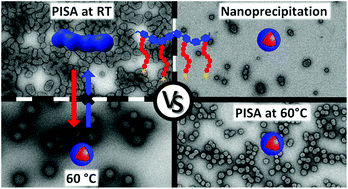Self-assembly of amphiphilic copolymers containing polysaccharide: PISA versus nanoprecipitation, and the temperature effect†
Abstract
For many decades, the self-assembly of amphiphilic copolymers containing polysaccharide, called glycopolymers, has been induced in water via nanoprecipitation, whereas the polymerization-induced self-assembly (PISA) approach has been less reported. Using advanced characterization techniques including static/dynamic light scattering and negative-stain/cryo TEM analyses, we studied the impact of the experimental conditions/process on the morphology of formed glyco-nanostructures. A model amphiphilic glycopolymer (Dex-g12-PHPMA400) based on dextran as hydrophilic polysaccharide backbone and poly(2-hydroxypropyl methacrylate) (PHPMA) as hydrophobic grafts was prepared in water using photo-induced RAFT polymerization at 405 nm. On the one hand, our findings revealed that photo-initiated PISA (photo-PISA) at room temperature (RT) led to a mixture of spheres with a significant population of worm-like micelles (WLM), whereas the nanoprecipitation of purified Dex-g12-PHPMA400 led only to spherical micelles. On the other hand, we demonstrate that the morphology of glyco-nanostructures is affected by temperature since performing photo-PISA at 60 °C led to spheres instead of WLM. Finally, our findings revealed that pre-synthesized WLM at RT underwent irreversibly an unusual morphological transition to spheres by heating to 60 °C.

- This article is part of the themed collection: Polymerization-Induced Self-Assembly (PISA)


 Please wait while we load your content...
Please wait while we load your content...